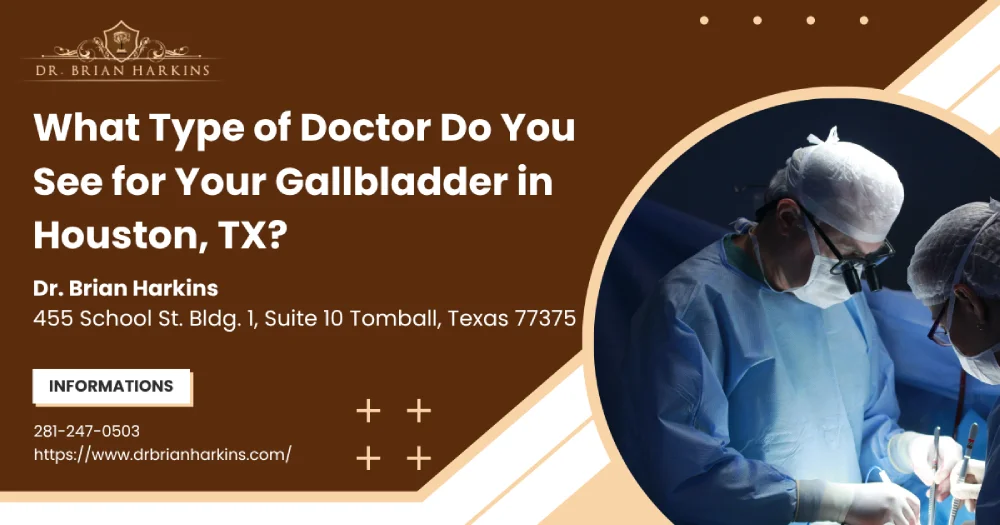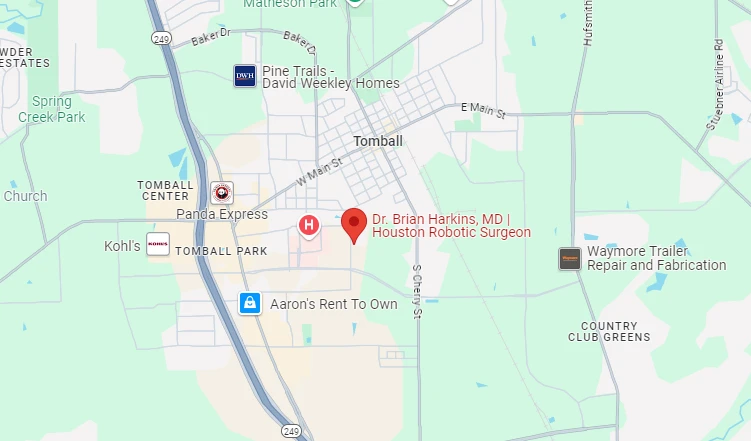
In Greater Houston, Texas, most people with gallbladder disease start with a gastroenterologist and, if gallstone pain persists, move on to a board-certified general surgeon or hepatobiliary surgeon for minimally invasive gallbladder surgery.
That familiar twinge under your right ribs, the bloating after brisket, or sharp abdominal pain can all be warning signs and symptoms of gallstones. When your gallbladder becomes inflamed or blocked—and you live in Houston, Katy, or Sugar Land—knowing which specialist near you can help is critical. Below you’ll find a clear guide to what type of doctor you see for your gallbladder in Houston, TX, how to choose one, and what to expect before gallbladder removal.
| Doctor Type | Typical Training & Certification | Why You Might See Them | Key Tests or Procedures | Referral Needed? |
|---|---|---|---|---|
| Gastroenterologist | Internal Medicine + 3-yr GI fellowship; board-certified | Early gallbladder symptoms, medical treatment for gallstones | Ultrasound, HIDA scan, MRCP, ERCP, medication | Usually yes |
| General Surgeon | 5-yr General Surgery residency; board-certified | Recurrent attacks, gallbladder polyps, confirmed stones | Laparoscopic or robotic cholecystectomy, cholangiography | Often after GI referral |
| Hepatobiliary Surgeon | General Surgery + HPB fellowship | Bile-duct injury, gallbladder cancer, large duct stones | Open or laparoscopic bile-duct repair, complex resection | Yes |
| Interventional Radiologist | Diagnostic Radiology + fellowship | High-risk patients needing drainage | Percutaneous cholecystostomy | ER or specialist referral |
Your gallbladder is a pear-shaped organ located beneath the liver. It stores bile produced in the liver and squeezes that bile into the small intestine to aid digestion—especially after fatty meals. When cholesterol or bilirubin hardens into gallstones inside the gallbladder, it can block the duct, trigger inflammation of the gallbladder (cholecystitis), or even affect the common bile duct.
Choosing between a gastroenterologist and a general surgeon hinges on symptom severity. Gastroenterologists at the Center for Digestive Health often treat gallstones without surgery, but if the gallbladder becomes scarred or stones keep returning, a surgical removal of the gallbladder—usually laparoscopic surgery—is recommended.
A gastroenterologist focuses on the digestive tract. Your doctor may review blood tests, request abdominal imaging, and perform ERCP to extract stones blocking the bile ducts without an incision. Medication like ursodiol can dissolve cholesterol stones, although many patients eventually need surgery.
If imaging shows multiple or large stones and you have symptoms of gallbladder disease, a board-certified general surgeon will likely recommend cholecystectomy. Laparoscopic gallbladder surgery uses four small incisions, making it a minimally invasive procedure with faster recovery than traditional open surgery.
For complex duct injuries or cancer, hepatobiliary surgeons at Houston Methodist Hospital, Baylor St. Luke’s, or the Texas Medical Center offer advanced open surgery and robotic options. They also handle cases when laparoscopic cholecystectomies fail or scar tissue blocks the bile ducts.
Gallbladder removal surgery is performed frequently, but seeking a second opinion—especially for symptomatic gallstones that do not cause constant pain—can clarify whether watchful waiting or immediate cholecystectomy is best.
Cholecystectomy is a minimally invasive procedure: one of the incisions hides in the belly button, and surgeons remove the gallbladder through that port. Average OR time is one hour, and most patients go home the same day of surgery.
Open surgery—through a larger incision on the abdomen—is reserved for scarred tissue, gallbladder cancer, or anatomy that prevents safe laparoscopic removal. Hospital stay may extend to several days at Methodist Hospital or another tertiary center.
Whether you’re in downtown Houston, Katy, or Sugar Land, you have access to top doctors for every type of gallbladder condition. Start with a gastroenterologist for diagnosis, move to a general surgeon for minimally invasive gallbladder removal if symptoms persist, and rely on hepatobiliary experts for complex disease. Track your symptoms, check insurance networks, and get the care you need to enjoy Texas barbecue again—without the gallbladder pain.
Start with a gastroenterologist for diagnosis and initial treatment, especially if your symptoms include abdominal pain after meals, bloating, or nausea. If gallstones or gallbladder disease are confirmed, a board-certified general surgeon typically performs the surgery to remove the gallbladder. For complex cases like bile duct injuries or cancer, you may need a hepatobiliary surgeon at a major center.
Laparoscopic surgery is generally safe even for patients in their 70s and 80s, provided they pass anesthesia clearance and blood tests. Minimally invasive techniques use smaller incisions, reduce infection risk, and shorten hospital stays, which is particularly beneficial for older adults who may have other medical conditions.
High-fat meals—fried chicken, full-fat dairy, and cheesy Tex-Mex—trigger gallbladder contractions and can worsen abdominal pain. Lower-fat options such as grilled fish, steamed vegetables, and high-fiber grains lessen bile demand and may temporarily ease symptoms while you await treatment for symptomatic gallstones.
Most patients resume light activity the day after surgery and desk work within one week. Complete internal healing, however, takes about four to six weeks. Following your surgeon’s advice on lifting limits and diet helps prevent complications and ensures a smooth recovery.
Once the gallbladder is removed, it cannot form new stones because the storage pouch is gone. Rarely, stones can still form in the common bile duct years later, usually because of residual fragments. Maintaining a balanced diet and staying hydrated can reduce this already low risk.
Robotic surgery offers the surgeon improved dexterity and 3-D visualization, which can benefit challenging cases. For routine gallbladder removal, outcomes—pain, scar size, recovery speed—are similar. Discuss your specific anatomy and the surgeon’s experience level before deciding which minimally invasive technique suits you best.
Most commercial plans, Medicare, and Medicaid cover cholecystectomy when imaging shows gallstones and you have documented symptoms. Always verify that both the surgeon and facility are in-network and obtain any required pre-authorization to avoid surprise billing from the hospital or anesthesia team.
Fever, worsening abdominal pain, persistent nausea, or jaundice can signal postoperative infection or bile-duct injury. Contact your surgical team immediately—or go to the ER—if these signs arise. Early intervention prevents serious issues from developing into major complications.
A diet low in saturated fat and high in fiber may decrease the risk of cholesterol stones. Maintaining a healthy weight and avoiding rapid crash diets also helps. Still, genetics, age, and hormonal factors mean some people form gallstones despite excellent eating habits.
Gentle walking is encouraged within 24 hours. Light cardio like stationary cycling can resume after two weeks if you feel comfortable. Wait a full four to six weeks before heavy lifting or intense core workouts to allow the tiny incisions in your abdomen to heal completely.


Dr. Brian Harkins is a renowned surgeon specializing in advanced, minimally invasive, and robotic surgical techniques. With a dedication to innovation and personalized patient care, he has transformed countless lives by delivering exceptional outcomes.

I want a website like this, where do i start?